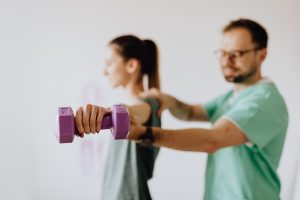Recovering from a stroke can be a challenging and overwhelming process, and many individuals may struggle with basic daily activities due to physical and cognitive impairments. This is where in-home occupational therapy can make a significant impact. An occupational therapist can work with stroke survivors to develop personalized treatment plans that focus on improving their ability to perform daily tasks. This may include exercises to improve strength and coordination, as well as strategies to compensate for any deficits. Occupational therapists can provide education on energy conservation and pacing to help stroke survivors conserve their energy and prevent fatigue. With the help of in-home occupational therapy, stroke survivors regain their independence and improve their quality of life.
Here are a few of the things an in-home occupational therapist can help a patient within the comfort of their own home.
 Motor skill recovery
Motor skill recovery
The first goal of occupational therapy is to help you regain control of your motor functions. This might include exercises that target movement, coordination, balance, and dexterity. Your therapist might use tools like pulleys, resistance bands, and weights to help facilitate your motor skill recovery.
Sensory integration
Following a stroke, you may experience sensory problems such as numbness, tingling, or decreased sensation on one side of your body. Your occupational therapist can help you recover sensory function by performing exercises that target specific sensory problems. Sensory exercises may include activities such as using different textures or temperatures to stimulate your senses.
Home modifications
Another aspect of occupational therapy is to modify your home so that it accommodates your specific needs in stroke recovery. Your therapist may suggest you to use ramps to avoid staircases, grab rails to provide support when walking and shower chairs for easier access to hygiene activities. Such modifications can help you perform activities of daily living with ease.
Adaptive equipment
An occupational therapist can assist you in the selection and installation of adaptive equipment that can help restore your independence. Examples of such equipment include splints or braces to support your limbs. Adaptive equipment may also include eating utensils designed to make eating easier.
Lifestyle modification
Occupational therapy can help you adjust your lifestyle to make your recovery easier. Through occupational therapy, you can learn how to manage stress, find time for exercise and improve meal planning. Such modifications can help you adapt to the changes brought on by a stroke, leading to a better quality of life.
Having occupational therapy can play a crucial role in stroke recovery. It helps stroke survivors regain their independence and lead a meaningful life. Through occupational therapy you can strengthen your motor skills, regain sensory function, modify your home, and adapt your lifestyle to support your recovery. Contact us to learn how our occupational therapist’s develop a therapy plan that is personalized to your specific needs and care.
